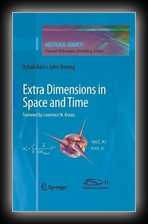
Extra Dimensions in Space and Time
by Itzhak Bars, John Terning, Farzad Nekoogar
2010
In physics, the idea of extra spatial dimensions originates from Nordstöm’s 5-dimensional vector theory in 1914, followed by Kaluza-Klein theory in 1921, in an effort to unify general relativity and electromagnetism in a 5 dimensional space-time (4 dimensions for space and 1 for time). Kaluza–Klein theory didn’t generate enough interest with physicist for the next five decades, due to its problems with inconsistencies.
With the advent of supergravity theory (the theory that unifies general relativity and supersymmetry theories) in late 1970’s and eventually, string theories (1980s) and M-theory (1990s), the dimensions of space-time increased to 11 (10-space and 1-time dimension).
There are two main features in this book that differentiates it from other books written about extra dimensions:
- The first feature is the coverage of extra dimensions in time (Two Time physics), which has not been covered in earlier books about extra dimensions. All other books mainly cover extra spatial dimensions.
- The second feature deals with level of presentation. The material is presented in a non-technical language followed by additional sections (in the form of appendices or footnotes) that explain the basic equations and formulas in the theories. This feature is very attractive to readers who want to find out more about the theories involved beyond the basic description for a layperson.
The text is designed for scientifically literate non-specialists who want to know the latest discoveries in theoretical physics in a non-technical language. Readers with basic undergraduate background in modern physics and quantum mechanics can easily understand the technical sections.
Part I starts with an overview of the Standard Model of particles and forces, notions of Einstein’s special and general relativity, and the overall view of the universe from the Big Bang to the present epoch, and covers Two-Time physics. 2T-physics has worked correctly at all scales of physics, both macroscopic and microscopic, for which there is experimental data so far. In addition to revealing hidden information even in familiar "everyday" physics, it also makes testable predictions in lesser known physics regimes that could be analyzed at the energy scales of the Large Hadron Collider at CERN or in cosmological observations."
Part II of the book is focused on extra dimensions of space. It covers the following topics: The Popular View of Extra Dimensions, Einstein and the Fourth Dimension, Traditional Extra Dimensions, Einstein's Gravity, The Theory Formerly Known as String, Warped Extra Dimensions, and How Do We Look For Extra Dimensions?
From the Back Cover
"…The Multiversal book series is equally unique, providing book-length extensions of the lectures with enough additional depth for those who truly want to explore these fields, while also providing the kind of clarity that is appropriate for interested lay people to grasp the general principles involved." -Lawrence M. Krauss
The aim of this book is to continue to raise public awareness in the exciting field of theoretical physics and cosmology. It covers the latest theories at a level not weighed down by highly mathematical equations. Each chapter is written by a leading expert who is presently researching and lecturing on the topics.
Extra Dimensions in Space and Time has two main features that differentiate it from all other books written about the topic: The first feature is the coverage of extra dimensions in time (Two-Time physics), which has not been covered in earlier books. All other books on the topic focus on extra spatial dimensions. The second feature deals with level of presentation.
The material is presented in a non-technical language followed by additional technical sections (in the form of appendices or footnotes) that explain the basic equations and formulas in the theories. This feature is very attractive to readers who want to learn more about the theories involved beyond the basic description for a layperson.
Topics Covered: Structure of matter & fundamental forces Einstein’s relativistic view of space-time Equivalence Principle and General Relativity Symmetry and perspective Why higher space or time dimensions? Extra space dimensions and String Theory Einstein and the Fourth Dimension Traditional Extra Dimensions String Theory and Branes Warped Extra Dimensions How to Look For Extra Dimensions? Extra Dimensions: The equations behind the words Two Time Physics Current status of 2T-Physics and future directions Multiversal Journeys™ is a trademark of Farzad Nekoogar and Multiversal Journeys, a 501(c)(3) nonprofit organization.
